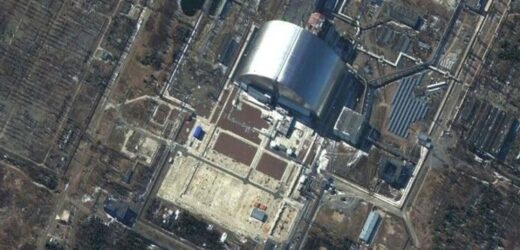Russia could use Chernobyl to 'blackmail' Europe says expert
We use your sign-up to provide content in ways you’ve consented to and to improve our understanding of you. This may include adverts from us and 3rd parties based on our understanding. You can unsubscribe at any time. More info
It has been nearly three weeks since Chernobyl — the site of the 1986 nuclear disaster — was captured by Russian forces at the beginning of Vladimir Putin’s invasion of Ukraine. The nuclear power facility is believed to have been of strategic importance to the Russian army, lying as it does on the route between the Belarus–Ukraine border and the Ukrainian capital of Kyiv, which today remains under siege. Since the seizure, the 211-strong complement of technicians and guards trapped at the site have been unable to rotate as they normally would, putting them under considerable strain.
Yuri Fomichev — the mayor of Slavutych, a city 31 miles from Chernobyl — told the Daily Mail that staff at the facility are short of food and the fuel needed for the plant’s emergency generators, which were brought into use last week following power supply issues.
He added that the treatment of Chernobyl personnel by Russian forces — who are reportedly being held at gunpoint — was putting the nuclear complex at risk of “a new accident”, and that a “humanitarian corridor” was needed to relieve staff.
Slavutych was purpose-built for the evacuated staff of the nuclear power plant following the meltdown in 1986; it is home to around 20,000 individuals and has been trapped behind the front line since the first day of the invasion.
Mr Fomichev said that his city faces “humanitarian catastrophe”, with Slavutych having been repeatedly disconnected from the power grid following damage to a high-voltage power line by Russian forces.
During a visit to Ukraine yesterday, Lithuanian European Commissioner Virginijus Sinkevičius also told Politico that he found the situation at Chernobyl “extremely worrying”.


International Atomic Energy Agency (IAEA) Director-General Rafael Grossi has repeatedly expressed concern over the conditions being faced by the Chernobyl staff — who, he said, were being forced to keep working “under enormous stress without the necessary rest”.
This pressure has been exacerbated in the last week, which saw the plant’s external power supply temporarily severed, along with communication with the outside world.
Warning that the situation is compromising one of the seven indispensable nuclear safety pillars outlined by the IAEA earlier this month, Director General Grossi added: “operating staff must be able to fulfil their safety and security duties and have the capacity to make decisions free of undue pressure.”
Ukraine’s national nuclear regulator has said that it is not clear whether nor when the Russian forces might permit arrangements for a much-needed shift change.
They also informed the IAEA for the first time yesterday that information they were receiving from Chernobyl was being “controlled by the Russian forces.”
Because of this, they explained, they were left unable to “always provide detailed answers to all” of the IAEA’s questions on the status of the nuclear power plant.
The regulator has said that the same issue is also affecting communications from the Zaporizhzhya nuclear power plant in the southeast of Ukraine, which has been under the control of Russian forces since March 4.


According to the Ukrainian regulator, eight of the country’s 15 reactors remain operational across the other four nuclear power plants, including one at Khmelnytskyi, three at Rivne, two at South Ukraine and two Zaporizhzhya, with radiation levels all in the normal range.
Staff at Zaporizhzhya — which is notable for being the largest nuclear power facility in the whole of Europe — have reportedly confirmed previous reports that the Russian military has been detonating unexploded munitions left around the site when it was captured on March 4.
Many of the munitions were said to be located in Zaporizhzhya’s training centre, which was shelled during the seizure earlier this month and caught fire — burning for hours before emergency services were able to extinguish the blaze.
According to reports relayed by IAEA, it seems that reactor technicians were not warned in advance that Russian forces would be setting off the unexploded armaments.
DON’T MISS:
Putin unleashes fury at Germany and HALTS gas flow from Russia [INSIGHT]
India hands Russia lifeline: Modi and Putin poised for huge deal [ANALYSIS]
ISS horror: Putin sparks panic for 2 NASA astronauts as they spacewalk [REPORT]

Elsewhere, in the northeast of Ukraine, staff have been able to return to the Kharkiv Institute of Physics and Technology, which was previously hit by Russian forces.
According to Ukraine’s nuclear regulator, staff have been able to restore the power supplies to safety systems that were damaged during the attack.
The facility is said to house both nuclear material and an experimental reactor — and is used for both nuclear research and development and also to produce radioisotopes for industrial and medical applications.
According to IAEA experts, the fact that the institute’s nuclear material is subcritical and kept in relatively small amounts means that “the reported damage would not have had any radiological consequence”.
Source: Read Full Article


